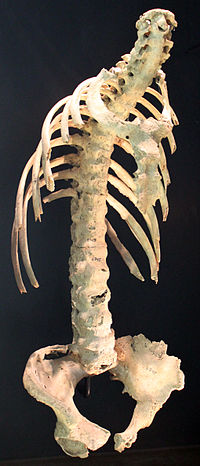
Photo from wikipedia
Abstract Sacral insufficiency fracture is becoming increasingly recognized as a complication of lumbosacral fusion, due to alteration of spinal biomechanics. Recognition of patient presentation is important because plain films may… Click to show full abstract
Abstract Sacral insufficiency fracture is becoming increasingly recognized as a complication of lumbosacral fusion, due to alteration of spinal biomechanics. Recognition of patient presentation is important because plain films may initially be negative with this complication. This case series of seven sacral insufficiency fractures following lumbosacral fusion characterizes key characteristics of presentation and management for sacral insufficiency fracture following lumbosacral fusion, which does not have a clearly defined algorithm for treatment. These seven fractures presented with initial complaints of back pain, lower extremity radicular symptoms, or a combination of the two. All identified fractures in this series were located below the inferior-most level of the fusion construct. Cross-sectional imaging such as computed tomography or magnetic resonance imaging was utilized in each case to make the diagnosis of sacral insufficiency fracture. Management depends on the patient’s presentation, symptoms, and fracture pattern, but treatment options include operative revision surgery and nonoperative modalities such as a standard rehabilitation protocol, lumbar bracing, and bone stimulators with close follow-up.
Journal Title: Baylor University Medical Center Proceedings
Year Published: 2022
Link to full text (if available)
Share on Social Media: Sign Up to like & get
recommendations!